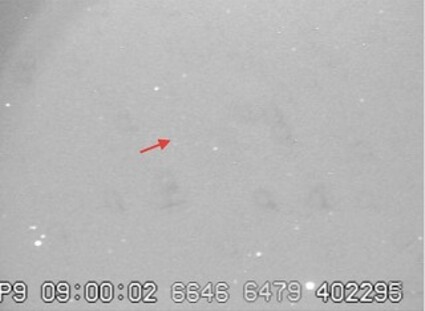Students brave cold to reach for stars
Last updated 12/20/2016 at Noon

This picture is a screen shot from the video file showing the star field that was being imaged. The white dots are stars. The red arrow points to the target star that is about 350 times fainter than naked-eye detection. photo provided
On the evening of Saturday, December 10, nine determined high school students and three adult advisors braved the elements to participate in a real science project contributing to astronomical research. It was the latest campaign of the Research and Education Collaborative Occultation Network (RECON), of which Sisters is a participating community.
RECON is a citizen-science program developed by Dr. Marc Buie of the Southwest Research Institute in Boulder, Colorado, and Professor John Keller at California Polytechnic State University in San Luis Obispo, California. Citizen science is research conducted, in whole or in part, by amateur or nonprofessional scientists, in this case, students and other volunteers from communities spaced 50 kilometers apart from Oroville, Washington on the Canadian border to Yuma, Arizona near the Mexican border.
The goal of RECON is to investigate objects at the outer regions of our solar system beyond the orbit of Neptune. Specifically, the effort is to measure the size of these trans-Neptunian objects, or TNOs, using the method of stellar occultation.
An occultation occurs when one celestial body moves in front of another, temporarily hiding it from view. In this case, a small, far-off world moves in front of a known star. The length of time between when the star winks out and when it reappears is proportional to the size of the obscuring object. And that's exactly what the intrepid group of volunteers was preparing to measure on that cold, occasionally snowy, Saturday night.
After finding a relatively solid surface of packed snow, a few of the students mounted the school's 11-inch computerized telescope on the tripod and locked it into position. Other students then began unpacking and attaching the necessary ancillary equipment, such as the finder scope and hand controller. Next, the camera, timing device and laptop computer were properly wired together and plugged into a portable battery which also powered the telescope.
After it had enough time to locate a sufficient number of GPS satellites, the telescope was able to calculate its geographic location on the earth. It was now time to align the telescope. Aided by a large patch of stars in a fleetingly clearing sky, two of the more experienced students, Alex Burroughs and Rylee Funk, chose three prominent stars in different parts of the sky for the alignment process. Shortly after the position of the third star was entered, the hand-held control paddle came back with "alignment confirmed." The team was in business.
The focus of attention this night was TNO Centaur 14UT114 and a very dim 15.7-magnitude star in the constellation of Perseus. Would the Sisters team, or any of the other 60-plus participating communities along the eastern spine of the Cascade and Sierra Nevada mountain ranges from northern Washington to Arizona see the star wink out?
The students successfully pointed the telescope to the area in the sky where the action would take place. By that time, however, clouds were on the increase, making the dimmer stars hard to see. Light from a nearly full moon also added to the problem. With about half an hour to go before the recording was to begin, everyone decided to take a break and get in out of the cold for a while.
When the group returned to the telescope, a very light snow flurry was in progress. Periods of partial clearing interspersed with intermittent flurries would be in play the rest of the night.
Using a keystroke command on the laptop, Alex started a video recording of the star field at 12:43 a.m. PST on Sunday, December 11 that ran for about 17 minutes. Because of the occasional clouds and light from the moon, the target star never was visible on the computer screen. Still, in a few days, one of the volunteers will upload the video file to a RECON server at the Southwest Research Institute in Colorado for analysis.
The Sisters RECON team will apply what they learned during this event to perhaps better prepare for the next campaign. Participating members of the RECON team that night were: Alex Burroughs, Taylor Frey, Ryan Funk, Rylee Funk, Wyatt Hernandez, Spencer Kemp, Delsie McCrystal, Jared Richardson and Ramsey Schaar. The adult advisors were Rima Givot, Jim Hammond, and Ron Thorkildson.















Reader Comments(0)